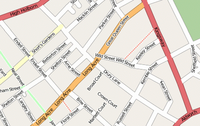Wikipedia
This text was copied from Wikipedia on 14 November 2024 at 5:11AM.


Drury Lane is a street on the eastern boundary of the Covent Garden area of London, running between Aldwych and High Holborn. The northern part is in the borough of Camden and the southern part in the City of Westminster. Drury Lane is part of London's West End Theatreland.
Notable landmarks

The street originated as an early medieval lane referred to in Latin as the Via de Aldwych, which probably connected St. Giles Leper Hospital with the fields of Aldwych Close, owned by the hospital but traditionally said to have been granted to the Danes as part of a peace treaty with King Alfred the Great in Saxon times. It acquired its name from the Suffolk barrister Sir Robert Drury, who built a mansion called Drury House on the lane around 1500. After the death in 1615 of his great-great-grandson, another Robert Drury, the property passed out of the family. It became the London house of the Earl of Craven, then a public house under the sign of his reputed mistress, the Queen of Bohemia. Subsequently, the gardens and courtyards of the house were built over with rows of small houses. The remains of the house itself, which had been progressively demolished, were finally cleared in 1809. By this time, Drury Lane had become one of the worst slums in London, dominated by prostitution[1] and gin palaces. The area was eventually cleared to make way for the developments of Kingsway and Aldwych.[2]
The Muffin Man resided on Drury Lane, according to the famous nursery rhyme.[3]
The term "Drury Lane" is often used to refer to the Theatre Royal, Drury Lane, which has in different incarnations been located in the street since the 17th century, even though today the main entrance is on Catherine Street. Also in Drury Lane is the Gillian Lynne Theatre.[4] 173 Drury Lane was the location of the first J Sainsbury store. The store was opened in 1869 and the company is now one of the UK's largest supermarket chains.[5]
See also
Notes
- ^ Sir Richard Steele in The Tatler (No. 46) gives a picture of Drury Lane as a district divided into particular "ladyships," analogous to "lordships" in other places, "over which matrons of known ability preside."
- ^ Bebbington, Gillian (1988) [1972]. Street Names of London. Batsford. p. 115. ISBN 978-0-7134-5449-9.
- ^ I. Opie and P. Opie, The Singing Game (Oxford: Oxford University Press, 1985), pp. 379–82.
- ^ "Gillian Lynne Theatre | Official Box Office". LW Theatres. Retrieved 13 December 2021.
- ^ Covent Garden and Holborn Young Trails - Camden Council, 2006 (booklet)
External links

- 'The Strand (northern tributaries): Drury Lane and Clare Market', Old and New London Volume 3 (1878), pp. 36–44. Date accessed: 18 March 2007.
- Drury Lane, In Their Shoes, Drury Lane history resource
51°30′54″N 0°07′22″W / 51.51500°N 0.12278°W / 51.51500; -0.12278
2 Annotations
First Reading
Terry F • Link
Drury Lane runs from the NW corner toward the SW in this segment of the 1746 map (but the location of the muffin man therein is not indicated) http://www.motco.com/map/81002/Se…
Second Reading
Bill • Link
Drury Lane, was so called, says Stow, "for that there is a house belonging to the family of the Druries. This lane turneth north toward St. Giles-in-the-Fields." Before the Drurys built here, the old name for this lane or road was "Via de Aldwych;" hence the present Wych Street at the bottom of Drury Lane. A portion of it in James I.'s time was occasionally called Prince's Street (" Drury Lane, now called the Prince's Street "), but the old name triumphed. In 1605 an Act was passed for "paving Drury Lane and the town of St. Giles," and it is stated in the preamble that "the lane called Drury Lane, leading from St. Giles-in-the-Fields towards the Strand and towards New Inn, is of late years by occasion of the continual rode there, and often carriages, become deep, foul, and dangerous to all that pass those ways."
---London, Past and Present. H.B. Wheatley, 1891.